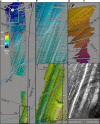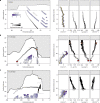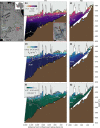Heterogeneous melting near the Thwaites Glacier grounding line
- PMID: 36792738
- PMCID: PMC9931587
- DOI: 10.1038/s41586-022-05691-0
Heterogeneous melting near the Thwaites Glacier grounding line
Erratum in
-
Publisher Correction: Heterogeneous melting near the Thwaites Glacier grounding line.Nature. 2023 Mar;615(7952):E21. doi: 10.1038/s41586-023-05861-8. Nature. 2023. PMID: 36829047 Free PMC article. No abstract available.
Abstract
Thwaites Glacier represents 15% of the ice discharge from the West Antarctic Ice Sheet and influences a wider catchment1-3. Because it is grounded below sea level4,5, Thwaites Glacier is thought to be susceptible to runaway retreat triggered at the grounding line (GL) at which the glacier reaches the ocean6,7. Recent ice-flow acceleration2,8 and retreat of the ice front8-10 and GL11,12 indicate that ice loss will continue. The relative impacts of mechanisms underlying recent retreat are however uncertain. Here we show sustained GL retreat from at least 2011 to 2020 and resolve mechanisms of ice-shelf melt at the submetre scale. Our conclusions are based on observations of the Thwaites Eastern Ice Shelf (TEIS) from an underwater vehicle, extending from the GL to 3 km oceanward and from the ice-ocean interface to the sea floor. These observations show a rough ice base above a sea floor sloping upward towards the GL and an ocean cavity in which the warmest water exceeds 2 °C above freezing. Data closest to the ice base show that enhanced melting occurs along sloped surfaces that initiate near the GL and evolve into steep-sided terraces. This pronounced melting along steep ice faces, including in crevasses, produces stratification that suppresses melt along flat interfaces. These data imply that slope-dependent melting sculpts the ice base and acts as an important response to ocean warming.
© 2023. The Author(s), under exclusive licence to Springer Nature Limited.
Conflict of interest statement
The authors declare no competing interests.
Figures














Comment in
-
High variability reveals complexity under Thwaites Glacier.Nature. 2023 Feb;614(7948):420-422. doi: 10.1038/d41586-023-00395-5. Nature. 2023. PMID: 36792732 No abstract available.
References
-
- Rignot E, et al. Recent Antarctic ice mass loss from radar interferometry and regional climate modelling. Nat. Geosci. 2008;1:106–110. doi: 10.1038/ngeo102. - DOI
-
- Mouginot J, Rignot E, Scheuchl B. Sustained increase in ice discharge from the Amundsen Sea Embayment, West Antarctica, from 1973 to 2013. Geophys. Res. Lett. 2014;41:1576–1584. doi: 10.1002/2013GL059069. - DOI
-
- Scambos TA, et al. How much, how fast?: A science review and outlook for research on the instability of Antarctica’s Thwaites Glacier in the 21st century. Global Planet. Change. 2017;153:16–34. doi: 10.1016/j.gloplacha.2017.04.008. - DOI
-
- Morlighem M, et al. Deep glacial troughs and stabilizing ridges unveiled beneath the margins of the Antarctic ice sheet. Nat. Geosci. 2020;13:132–137. doi: 10.1038/s41561-019-0510-8. - DOI

